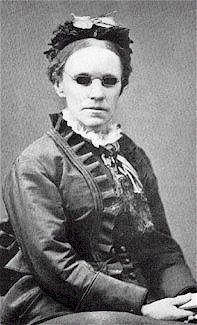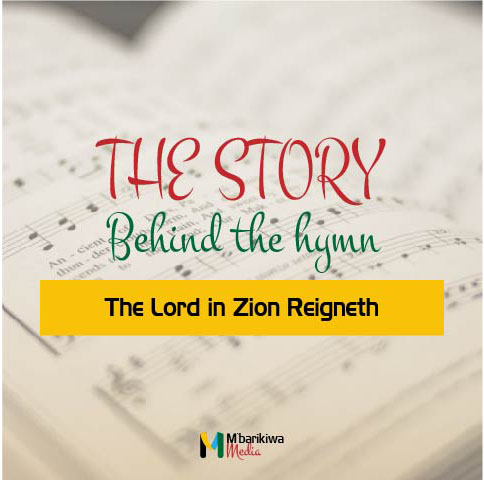This hymn, The Lord in Zion Reigneth was written by Frances Jane Crosby.

Frances Jane Crosby, the daughter of John and Mercy Crosby, was born in Southeast, Putnam County, N. Y., March 24, 1820. She became blind at the age of six weeks from maltreatment of her eyes during a spell of sickness. When she was eight years old she moved with her parents to Ridgefield, Conn., the family remaining there four years. At the age of fifteen she entered the New York Institution for the Blind, where she received a good education. She became a teacher in the institution in 1847, and continued her work until March 1, 1858. She taught English grammar, rhetoric and American history.
This was the great developing period in her life. During the vacations of 1852 and 1853, spent at North Reading, Mass., she wrote the words to many songs for Dr. Geo. F. Root, then the teacher of music at the blind institution. Among them were, “Hazel Dell,”, “The Honeysuckle Glen,” “Rosalie, the Prairie Flower,” “Music in the Air,” “Proud World, Good-bye, I’m Going Home,” “All Together”, “Never Forget the Dear Ones,” and others. Subsequently she wrote the words for the cantatas of The Flower Queen and The Pilgrim Fathers, all of which were very popular in their day, though it was not generally known at the time that she was the author.
While teaching at the institution she met Presidents Van Buren and Tyler, Hon. Henry Clay, Governor Wm. H. Seward, General Winfield Scott, and other distinguished characters of American history. Concerning Mr. Clay, she gives the following: “When Mr. Clay came to the institution during his last visit to New York, I was selected to welcome him with a poem. Six months before he had lost a son at the battle of Monterey, and I had sent him some verses. In my address I carefully avoided any allusion to them, in order not to wound him. When I had finished he drew my arm in his, and, addressing the audience, said through his tears: ‘This is not the first poem for which I am indebted to this lady. Six months ago she sent me some lines on the death of my dear son.’ Both of us were overcome for a few moments. Soon, by a splendid effort, Mr. Clay recovered himself, but I could not control my tears.” In connection with her meeting these notable men, we might add that Miss Fanny Crosby had the honor of being the first woman whose voice was heard publicly in the Senate Chamber at Washington. She read a poem there on one occasion. In addition to the thousands of hymns that she has written (about eight thousand poems in all), many of which have not been set to music, she has published four volumes of verses. The first was issued in 1844 and was entitled The Blind Girl, and Other Poems, a second volume, Monterey, and Other Poems, followed in 1849, and the third, A Wreath of Columbia’s Flowers, in 1858. The fourth, Bells at Evening and Other Verses, with a biographical sketch by Rev. Robert Lowry, and a fine half-tone portrait, in 1897, the sales of which have reached a fourth edition. The book is published by The Biglow & Main Co., New York.
Though these show the poetical bent of her mind, they have little to do with her world-wide fame. It is as a writer of Sunday-school songs and gospel hymns that she is known wherever the English language is spoken, and, in fact, wherever any other language is heard.
Fanny was married March 5, 1858, to Alex. Van Alstyne, who was also a scholar in the same institution in which she was educated.
She began to write Sunday-school hymns for Wm. B. Bradbury in 1864. Her first hymn,
“We are going, we are going
To a home beyond the skies”,
was written at the Ponton Hotel on Franklin Street, New York City, on
February 5th of that year. This hymn was sung at Mr. Bradbury’s funeral
in January, 1868. Since 1864 she supported herself by writing hymns. She
resided in New York City nearly all her life, where, she says, she is
“a member of the Old John Street M. E. Church in good standing.” She
spent regular hours on certain days at the office of The Biglow &
Main Co., the firm for which she did most of her writing, and for whom
she has composed over four thousand hymns. Her hymns have been in great
demand and have been used by many of our most popular composers, among
whom may be mentioned Wm. B. Bradbury, Geo. F. Root, W. H. Doane, Rev.
Robert Lowry, Ira D. Sankey, J. R. Sweney, W. J. Kirkpatrick, H. P.
Main, H. P. Danks, Philip Phillips, B. G. Unseld, and others. She could
compose at any time and did not need to wait for any special
inspiration, and her best hymns have come on the spur of the moment. She
always composed with an open book in her hand, generally a copy of Golden Hymns,
held closely over her eyes, bottom side up. She learned to play on the
guitar and piano while at the institution, and has a clear soprano
voice. She also received a technical training in music, and for this
reason she could, and did, compose airs for some of her hymns. One of
these is,
“Jesus, dear, I come to Thee,
Thou hast said I may,”
both words and music of which are wonderfully sweet. “Safe in the arms
of Jesus”, probably one of her best known hymns, was her own favorite.
Fanny loved her work, and was happy in it. She was always ready either
to sympathize or join in a mirthful conversation, as the case may be.
The secret of this contentment dates from her first composition at the
age of eight years. “It has been the motto of my life,” she says. It is:
“O what a happy soul am I!
Although I cannot see,
I am resolved that in this world
Contented I will be;”
This has continued to be her philosophy. She says that had it not been for her affliction she might not have so good an education, nor so great an influence, and certainly not so fine a memory. She knows a great many portions of the Bible by heart, and had committed to memory the first four books of the Old Testament, and also the four Gospels before she was ten years of age.
Her scope of subjects is wide, embracing everything from a contemplation of heaven, as in “The Bright Forever” and “The Blessed Homeland”, to an appeal to the work of this world, as in “To the Work” and “Rescue the Perishing.” The most of Fanny’s published hymns have appeared under the name of Fanny J. Crosby or Mrs. Yan Alstyne, but quite a large number have appeared under the nom de plumes of Grace J. Frances, Mrs. C. M. Wilson, Lizzie Edwards, Ella Dale, Henrietta E. Blair, Rose Atherton, Maud Marion, Leah Carlton, nearly two hundred different names.
References.

